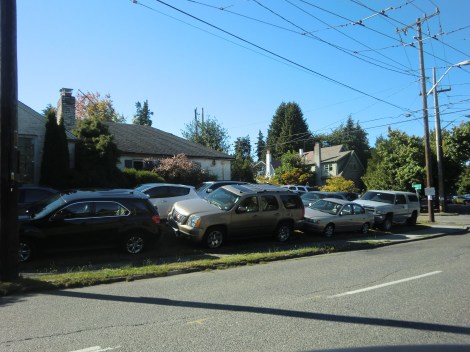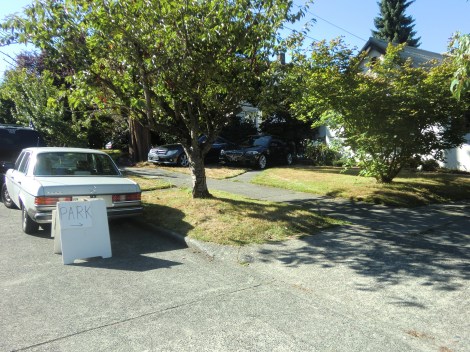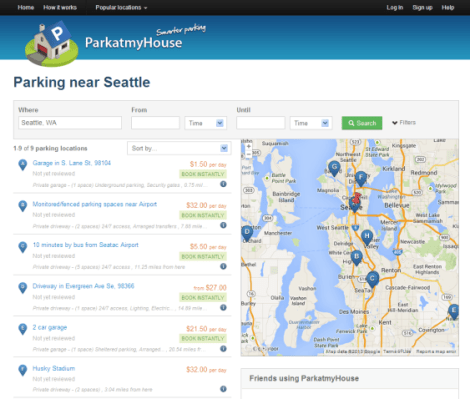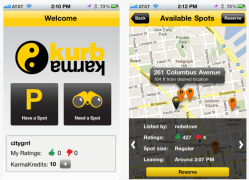This is part 11 of a Sightline series on parking requirements. Read parts 1, 2, 3, 4, 5, 6, 7, 8, 9, and 10.

Judy DaileyGame day near the University of Washington’s stadium.
In Peggy Clifford’s neighborhood, out back of the state capitol in Olympia, Wash., a black market thrives. Early each year during the state’s legislative session, lobbyists go there — just a hop, skip, and a jump from the capitol dome — to buy what they crave: parking spaces. Clifford says, “This is a neighborhood, not a parking lot.”
Tell that to regular capitol visitors. The neighborhood may be nationally registered as historic and staunchly defended by Clifford and other concerned citizens, but it also has driveways and backyards, and to some residents, the offer of hard currency for use of that real estate is persuasive. They park their cars at the curb, protected by their resident-only permits, and rent out their private spaces to professional capitol-goers. A lot of money changes hands.
Later each year, in August and September, similar informal markets pop up around two of the Northwest’s biggest fairs: the Puyallup in Washington and the Pacific National Exhibition in Vancouver, B.C. Neighbors stand curbside, like sign twirlers or squeegee men, hawking space on their property to the drivers streaming by. In Puyallup, the practice goes back for decades; local authorities long ago threw up their hands. They legalized and regulated it. In Vancouver, where not only homeowners but also local schools and churches sell spots, city leaders did the same. They wrote exacting standards, then began publishing helpful tips for would-be parking operators.
It’s the same thing on game days at Oregon State University and the University of Washington (pictured above and below), and during the Seafair hydroplane races in Seattle. Homeowners in resident-only parking districts shuttle their autos to the curb at dawn and rent their off-street spaces to visitors. Other sporting events spark the same phenomenon. When Seattle’s Stacy Noland lived near the arena then used by the Seattle Supersonics, he made enough money letting basketball fans park in his garage to pay for his own season tickets. “Meanwhile, I parked my rig on the street,” Stacy says.

Judy DaileyGame day near UW’s stadium.
Parking apps
Tech entrepreneurs have begun buzzing around the sleepy backwater of the parking business, and they’ve noticed such informal schemes. They’re rushing to create apps to turbocharge and regularize them, not to encourage more parking on front lawns but to make it easier for parkers and the owners of legal parking spots to find each other. They’re also making inroads into the market for pay parking at meters, in garages, and on lots. More than 25 parking apps now stock the digital bodegas of the cloud, each vying for dominance, each with its own niche and pitch.

ParkatmyHouse, for example, is the Airbnb of parking spaces. It’s a bazaar where drivers can find and rent homeowners’ spots. Launched in London, where more than 150,000 people use it to do business over 40,000 stalls, it’s now active in the Eastern United States and is beginning to catch on in the Northwest.
Others, such as Chicago-based ParkWhiz, focus less on person-to-person matchmaking and more on garages. ParkWhiz has joined forces with online ticket sellers to bundle its offerings with shows. Parker, meanwhile, is the app created by Street Line, a technology innovator that sells parking hardware such as meters and sensors. Parking Panda tries to serve both garages and private homes in six cities from Washington, D.C., to San Francisco, with a few listings now beginning in the Northwest. SpotHero emphasizes advance reservations and discounted rates. Best Parking focuses on becoming the most comprehensive directory of public garages.
 There are others, many of them. ParkMe claims to have the world’s most comprehensive parking database, covering more than 1,800 cities in 32 countries.* ParkShark and KurbKarma are less about selling than about cooperating, more like Couchsurfing than Airbnb. In cities where they operate, such as New York and San Francisco, they let people notify other app users when they’re vacating a space. Parkopedia, meanwhile, is both cooperative and ambitious: a crowd-sourced wiki on garages, lots, and street parking — rates, location, even current availability.
There are others, many of them. ParkMe claims to have the world’s most comprehensive parking database, covering more than 1,800 cities in 32 countries.* ParkShark and KurbKarma are less about selling than about cooperating, more like Couchsurfing than Airbnb. In cities where they operate, such as New York and San Francisco, they let people notify other app users when they’re vacating a space. Parkopedia, meanwhile, is both cooperative and ambitious: a crowd-sourced wiki on garages, lots, and street parking — rates, location, even current availability.
 Some just focus on easing the process of paying for parking. Vancouver, B.C.-based PayByPhone Parking allows people to use an app (or a telephone call) to pay for parking at 8,000 street meters across Vancouver without ever exiting the car. It also lets you add to the meter from wherever you might be. PayByPhone is available in dozens of cities across the U.S. and Canada. A similar app is Pango, which claims half a million users in more than 50 cities, including some in Europe and the Middle East. Some operators of private lots and garages have their own apps, such as QuickPay, Central Parking, and Park Mobile. From Parkbud to Roadify, from Take Me to My Car to Honk, parking apps just keep coming.
Some just focus on easing the process of paying for parking. Vancouver, B.C.-based PayByPhone Parking allows people to use an app (or a telephone call) to pay for parking at 8,000 street meters across Vancouver without ever exiting the car. It also lets you add to the meter from wherever you might be. PayByPhone is available in dozens of cities across the U.S. and Canada. A similar app is Pango, which claims half a million users in more than 50 cities, including some in Europe and the Middle East. Some operators of private lots and garages have their own apps, such as QuickPay, Central Parking, and Park Mobile. From Parkbud to Roadify, from Take Me to My Car to Honk, parking apps just keep coming.
Information technology in the parking economy is still a fledgling, and most of these apps may never fly successfully. But some will, and the parking economy — and our communities — will be the better for it. They’ll make it easier to find parking, easier to pay for parking (no more guessing how long you’ll stay, no more trudging back to pay for more parking), and easier for parking enforcers to do their job. In short, they’re making the economics of parking more like a functioning market. They are also helping to clear a path toward other reforms.
Netflix and the rationality of cheating
In my last article, I gave three reasons parking is such a weird commodity. There’s a fourth: Parking is innately difficult to sell. It is fundamentally just space — dispersed spaces, specifically. And dispersed locations are hard to find and to patrol. Because it’s dispersed and not sold in the same transaction as anything else, it’s hard to charge for. In economic terms, parking has high “transaction costs.” Finally, even though parking is wickedly expensive in the aggregate, the hourly market price for most individual parking places is low, especially because parking quotas have bloated supply. In small cities and towns and outside of big-city downtowns, it’s dimes or quarters an hour, not dollars.
Hood River, Ore., for example, charges 35 cents an hour at its few downtown meters. Over a month, that’s $250 of rent — a reasonable reflection of real estate values in Hood River. But 35 cents an hour doesn’t cover the cost of installing and operating smart meters of the type now common in the Northwest’s big cities. It might not even cover the cost of simple, coin-operated meters plus parking enforcement. Most small cities consider charging for parking and back away, seeing that leaving on-street parking free is easier on the municipal budget.
Imagine an alternative universe in which Netflix has to go door-to-door to check whether people are using its service. The whole system would break down. Many millions of people would be willing to make small monthly payments to get access to shows, but because Netflix couldn’t tell who was using its service, most people would cheat. They’d watch without paying. The company would go bankrupt.
The parking economy is like this alternative-universe Netflix. Millions of dispersed parking spots are each worth a modest sum to their users, but patrolling them and collecting payment from drivers who unceasingly shift their cars in and out of spaces is a laborious, inefficient process. It’s a recipe for widespread enforcement failures. Because enforcement is notoriously spotty, cheating proliferates. In Seattle, one study found that on-street parkers stayed twice the specified time limit, on average (see page 297). And many parking enforcement managers across the continent figure that 90 percent of people who overstay their meters get away with it, according to LA Magazine. In such circumstances, cheating can be rational: if you’re only caught one time in10, and parking fines are modest, why not take your chances? You’ll likely pay less in the long run.
Fortunately, information technology is insinuating itself into parking, as it is into so many other parts of the economy, and slashing transaction costs. Apps are making it easier to find parking. Pay-by-phone systems, which track license plates, make it easier to plug the (virtual) meter. Automatic license-plate scanners on parking enforcement scooters are making enforcement dramatically more efficient. Meter readers can zip along block after block, checking for vehicles that aren’t paid up. Finally, some cities are beginning to install hockey-puck-size in-ground sensors that wirelessly convey to a city database whether each space is occupied. The database tracks which occupied spaces are not paid, and parking enforcers follow on-board computers from one violator to the next, issuing tickets as fast as they can go. Better enforcement, in turn, is making cheating less rational. It’s making parking more like Netflix.
Meanwhile, technologists and entrepreneurs are already competing to make in-ground parking sensors (which currently cost about $200 apiece) unnecessary, as GreenBiz reports. They are trying to invent systems for parking payment and enforcement that employ cars’ onboard navigation systems, cellphones’ internal locator features, and possibly even visual recognition software running on security cameras. What combination of devices will ultimately prevail is anyone’s guess. What’s certain is that the full force of technological innovation is belatedly disrupting the parking business as it has so many others.
The advent of smart parking systems will not be smooth and uniform, of course. Different cities and parking garages currently use incompatible databases, for example, which is slowing the development of a single, uniform parking-availability app: a Google Maps of parking that all GPS, on-board navigation systems, and smart phones can tap into. Worse, there’s a digital parking divide: Many people do not have GPS, a smartphone, or even a credit card, so old-fashioned, cash-based back-up systems will still be needed. But the question is not whether but when information technology will reach each corner of the parking economy. By lowering transaction costs and making parking more of a regular market, information technology is opening the door to improvements more profound than the end of rushing out to feed the meter. For one thing, it is making charging for parking cost-effective at a much larger share of spaces. For another, it’s changing parking politics.
The political implications of parking markets
In Peggy Clifford’s part of Olympia, Wash., for example, new technology — if authorized by the city — could allow the neighborhood association to begin renting use of on-street curb spaces to lobbyists, undercutting the black market for off-street spaces and harvesting a mountain of cash for community projects. (I’ll discuss such systems further in a future article; they’re important because they tame the weird interactions of private and public parking.) The same solution might work to prevent the packing of yards with cars at Northwest universities on game days.
More generally, the emergence of an efficient marketplace for individual parking places will reorder neighborhood parking politics, as Matt Yglesias has argued. If parking markets are active not only around fairs and sporting events, when extreme numbers of cars make the payoff big enough to lure property owners curbside and turn them into entrepreneurs, but also in hundreds of other neighborhoods where parking is only moderately scarce, the balance of parking power may shift. It will make the value of individual slots available to their owners. Some of those owners will realize that off-street parking quotas depress the price they can charge for their own spaces.
If I can rent my unused driveway to a local apartment dweller for $100 a month through Parkatmyhouse, I may not speak up for new off-street parking at nearby developments when I talk to my city councilors. I may, in fact, do the opposite. I may welcome new apartments that have little off-street parking themselves, figuring my driveway’s price might rise to $150 a month when all those newcomers arrive. My self-interest, and that of others who rent out extra spots, will begin to form a counterweight to the parking territoriality that currently dominates local politics. The shift may be subtle but it could be important. In combination with several other shifts, which I’ll write about in the next few articles, it could lead to the withering away of the parking quotas that inflict so much harm in our communities.
*Correction: An earlier version of this article stated ParkMe covers 500 cities on three continents. We’ve updated the numbers.




